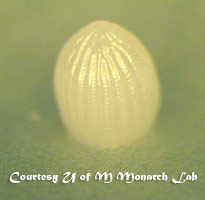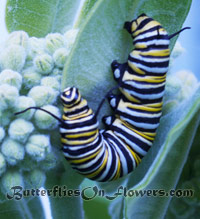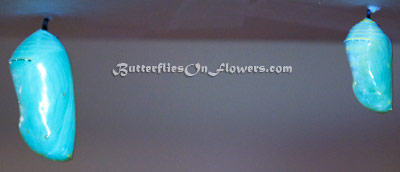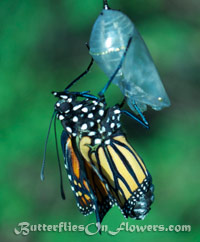The Four Butterfly Stages in Monarch Butterfly Metamorphosis

The egg is the first of four monarch butterfly stages that make up the
monarch butterfly metamorphosis. The duration of this first stage is 4-7 days, making this the shortest of the four stages of a butterfly. (Colder weather accounts for slower hatching times.)
The egg can be easily missed by the naked eye at roughly 1.2 millimeters long or 1/32 inches. The whitish egg is spherical in shape and has vertical ridges.
Many caterpillars will never see the light of day as opportunistic predators devour this incredible edible egg. |
|---|

The caterpillar is the second of four monarch butterfly stages that make up the butterflies life cycle. The duration of this stage is roughly 9-14 days and is on the long end when temps are colder.
The majority of the time spent in this stage is focused on eating... and the finicky caterpillar won't settle for anything but its favorite weed.
Monarch Caterpillars are categorized by size, and the different sizes are referred to as instars. Instar 1, the caterpillar is approximately 2-6 millimeters. By the 5th instar the caterpillar has reached 25-45 millimeters. Just like humans, monarch caterpillars vary in size. Recently, I had a caterpillar that appeared to be 3rd instar who proved me wrong by defiantly forming a chrysalis! In case you were wondering, a small caterpillar will transform into a small monarch butterfly.
A caterpillar sheds its skin 5 times throughout its caterpillar life cycle. The fifth time she does it a little differently by hanging upside down before shedding her way into stage 3 of the 4 stage life cycle.

The pupa or chrysalis is the third of four monarch butterfly stages in the butterly transformation cycle. The time spent in this stage ranges between 10-14 days, with colder temps slowing down the process. By colder, I mean below 60 degrees F(15.56 degrees C)and 50 degrees F(10 degrees C)in sunny weather.
When the caterpillar first sheds her skin to reveal the chrysalis, it is soft and misshapen. Amazingly, it always hardens into perfect form. |
|---|
The chrysalis is a vibrant emerald green and this is by design. The monarch is completely defenseless during stage 3 and the only way to avoid harmful predators is by camouflage. Green is the perfect color to blend in with summer.
From outside the pupa, all seems calm. But inside, the caterpillar is rapidly morphing from larva to a fully formed adult butterfly. The final few days in this stage you will notice the chrysalis progressively darken. As this happens, you'll also begin to see the markings of the monarch butterfly. On hatching day, the pupa is completely transparent previewing what's about to transpire.

The butterfly is the fourth and final of the monarch butterfly stages that make up the butterfly life cycle. Most adult monarchs will live just long enough to mate and frequent a few butterfly gardens.
During this period, the monarch no longer needs milkweed as he is done growing. His taste has evolved and the butterfly uses his new elongated mouth appendage to suck nectar from his favorite flowers.
This monarch "straw" is called a proboscis and he rolls it out of his mouth like a reverse red carpet. The nectar's main purpose is to provide the adult with energy.
Each spring and summer, 5 generations of monarchs go through this exciting month-long transformation.
The fifth generation survives almost 9 months and before they mate, they will journey to a remote destination thousands of miles away.
Return from Butterfly Stages to Monarch Butterfly





